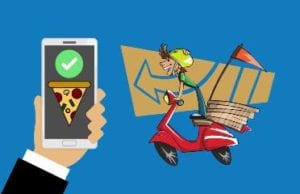Delivery apps like Favor and UberEats have become all the rage since first appearing almost a decade ago. Many restaurants and retailers saw the apps as a low-cost way to boost to-go restaurant and to-go retail sales. These days, people are looking for easy ways to get the supplies they need without interacting with people. However convenient the apps may appear, they may actually be hurting many businesses.

Image credit Kai Pilger
When a customer uses a delivery app, the profit margin for a restaurant, for example, is minimal. On average, these services charge around a 30 percent delivery fee. Some apps are charging restaurants up to 50 cents per every dollar. In the restaurant biz, the profit margin is already notoriously low. According to most operators, restaurants budget 30 percent of revenue for the cost of ingredients, 30 percent for the cost of labor, and the remainder for “everything else”— rent, utilities, insurance, supplies, credit-card fees, and profit.
Companies like GrubHub maintain the revenue they bring to restaurants is “incremental” –– additional sales. They also argue that their orders are a form of marketing. The apps, they believe, are exposing a business to new people who will likely convert to in-person customers. The problem with these assertions is that neither are true, according to many studies.
Delivery Apps Take Profits Away from Businesses
In 2016, delivery orders made up about seven percent of total U.S. restaurant sales. Analysts at Morgan Stanley predicted that number could jump to 40 percent or higher –– and that was before the pandemic. A recent article in The New Yorker suggested that as consumers use services like Uber Eats and Seamless for a greater share of their meals, delivery orders are beginning to replace some restaurants’ core business instead of complementing it. A Morgan Stanley survey found that 43 percent of delivery patrons said their delivered meal was replacing one they would have otherwise eaten at a restaurant.
Last year, a number of restaurant owners joined a class action lawsuit against Grubhub. The suit alleged the service was sneakily charging restaurants up to hundreds of dollars more a month. The suit alleges that the delivery app was counting non-order calls as orders, and charging restaurants for things like customer questions or complaints.
How to Take on Delivery Apps
Taking on these delivery services requires major adjustments in terms of operations, pricing, and expectations. Most businesses have already adapted to the quarantine. Unfortunately, even restaurants who don’t sign up for these apps have to get in on the fight. Some owners say their businesses are appearing on delivery sites without their permission. This leads to customers thinking they can get delivery from restaurants that don’t offer it. Sometimes those unhappy folks leave negative reviews over something a restaurant never promised.
The best way to support your local businesses is to call them directly. Most places that have stayed open offer curbside pickup or make their own deliveries. Curbside pickup is also a safer way to order restaurant to-go and retail to-go products. When you order from businesses directly, you’re helping them stay open and hold on to employees. Help your community by avoiding delivery apps when possible.





